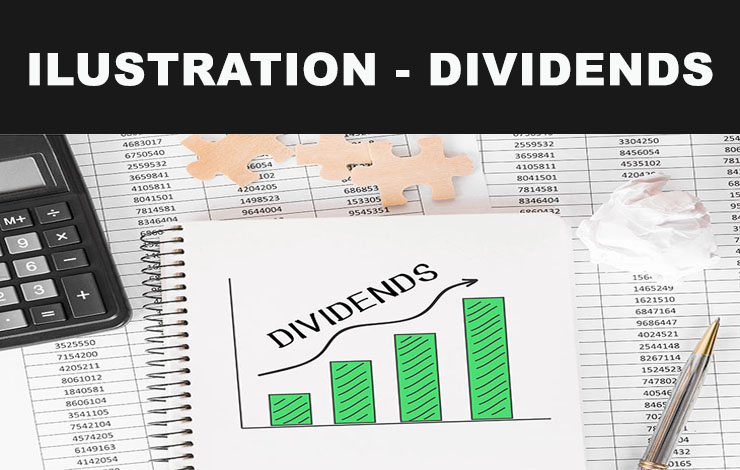When it comes to investing in stocks, a popular approach is to look for stocks that offer consistent returns through dividends. Dividends are regular payments made by companies to shareholders, usually based on profits made.
In this article, we’ll explore important questions about how to select stocks that offer consistent returns through dividends, providing up-to-date and truthful information to help you make informed decisions when investing.
What are dividends and why are they relevant to investors?
Dividends are payments made by companies to shareholders as a portion of the profits made. They are a way to reward investors and share the company’s positive financial results. Dividends are usually paid regularly, quarterly or annually, and are a source of income for shareholders.
Dividends are relevant to investors for several reasons. First, they offer a source of regular cash flow, which can be especially attractive to investors looking for stable income. Second, dividends can be an indication of a company’s financial health and performance, as well-established and profitable companies tend to distribute consistent dividends over time.
What are the key stock selection indicators to invest in dividends?
When selecting stocks that offer consistent returns through dividends, it’s important to consider several key indicators. Here are some of the key indicators to evaluate:
a) Dividend Yield: The dividend yield is calculated by dividing the annual dividend amount by the current share price. This indicator shows the percentage of annual return that dividends can represent in relation to the share price. A higher dividend yield may indicate a greater potential for return through dividends.
b) Dividend Payment History: Check the company’s dividend payment history. Companies that have a consistent history of dividend payments are more likely to continue to do so in the future. This can be a sign of financial stability and confidence in the continued generation of profits.
c) Dividend Growth Rate: Evaluate the dividend growth rate over time. Companies that consistently increase dividend payouts can be attractive to investors looking for increasing returns over time.
d) Payout Ratio: The payout ratio is the proportion of the company’s profits that is distributed as dividends. A healthy payout ratio indicates that the company is balancing dividend payments with capital retention for future investments. Generally, a payout ratio below 70% is considered sustainable.
e) Financial Indicators: In addition to the specific dividend indicators, it is important to evaluate the company’s general financial indicators, such as profitability, indebtedness, revenue growth and cash flow. A financially healthy company is more likely to maintain consistent dividends.
Which sectors often offer attractive dividends?
While dividend opportunities are available in a variety of industries, some industries are known to offer attractive dividends. These sectors include:
a) Energy Sector: Energy companies, such as those in the oil and gas sector, often have attractive dividends. These companies often generate consistent and stable cash flows, which can allow for regular dividend payments.
b) Public Utilities Sector: Utility companies, such as electricity, gas and water, are often considered stable dividend investments. These companies operate in regulated industries and provide essential services, which can result in stable cash flows and consistent dividend payments.
c) Telecommunications Industry: Telecommunications companies, such as fixed and mobile telephony companies, often offer attractive dividends. These companies can have a stable and predictable cash flow due to the ongoing demand for communication services.
d) Non-Durable Consumer Sector: Companies that manufacture or distribute non-durable consumer goods, such as food, beverages, and personal care products, can also be sources of consistent dividends. These companies meet the ongoing demand for essential products, which can contribute to a stable cash flow.
How to perform a fundamental analysis to select dividend stocks?
Performing a fundamental analysis is essential for selecting dividend stocks. Here are some important steps to follow:
a) Analyze the fundamentals of the company: Evaluate the company’s key financial indicators, such as revenue, net income, profit margins, debt, and cash flow. A financially sound company is key to sustaining consistent dividends.
b) Evaluate the dividend history: Check the company’s dividend payment history over the years. Analyze whether there has been consistent dividend growth and whether the company has been able to maintain payments even in challenging periods.
c) Consider dividend sustainability: Evaluate the company’s ability to maintain dividend payments over the long term. Analyze the relationship between earnings, payout ratio, and cash flow to determine whether the company is properly balancing dividend payments with capital retention for reinvestments.
d) Research the company’s and industry’s perspective: Analyze the growth perspective of the company and the industry in which it operates. Consider factors such as competition, regulatory changes, technological innovations, and consumer trends that could impact dividends in the future.
e) Diversify your dividend portfolio: It is important to diversify your dividend portfolio by investing in companies from different sectors and with varying sizes. This will help reduce industry-specific risk and increase the chances of receiving consistent returns.
What are the risks associated with dividend investments?
While investing in dividend stocks can be attractive, there are risks to consider:
a) Risk of diminishing dividends: Companies may reduce or suspend dividend payments due to financial difficulties, changes in the industry, or other factors. It is important to be prepared for the possibility of a reduction in dividend payments.
b) Market performance risk: The performance of dividend stocks may be affected by stock market fluctuations. The stock price may fall, which can affect the value of the investment, even with dividend payments.
c) Concentration risk: If the portfolio is concentrated in a limited number of dividend-paying stocks, the specific risk of these companies can affect the overall returns of the portfolio. It is important to diversify the portfolio to mitigate this risk.
What did we learn in this article?

Ilustration – Dividends
Investing in stocks that offer consistent returns through dividends can be an attractive strategy for investors looking for stable cash flow and long-term growth potential.
When considering dividend investments, it is essential to evaluate key indicators such as dividend yield, dividend history, growth rate, payout ratio, and overall financial indicators of the company. In addition, conducting a comprehensive fundamental analysis and diversifying the portfolio are important steps to mitigate risk and seek consistent returns over time.
With up-to-date information and a strategic approach, you can select dividend stocks that align with your financial goals in 2023 and beyond.
